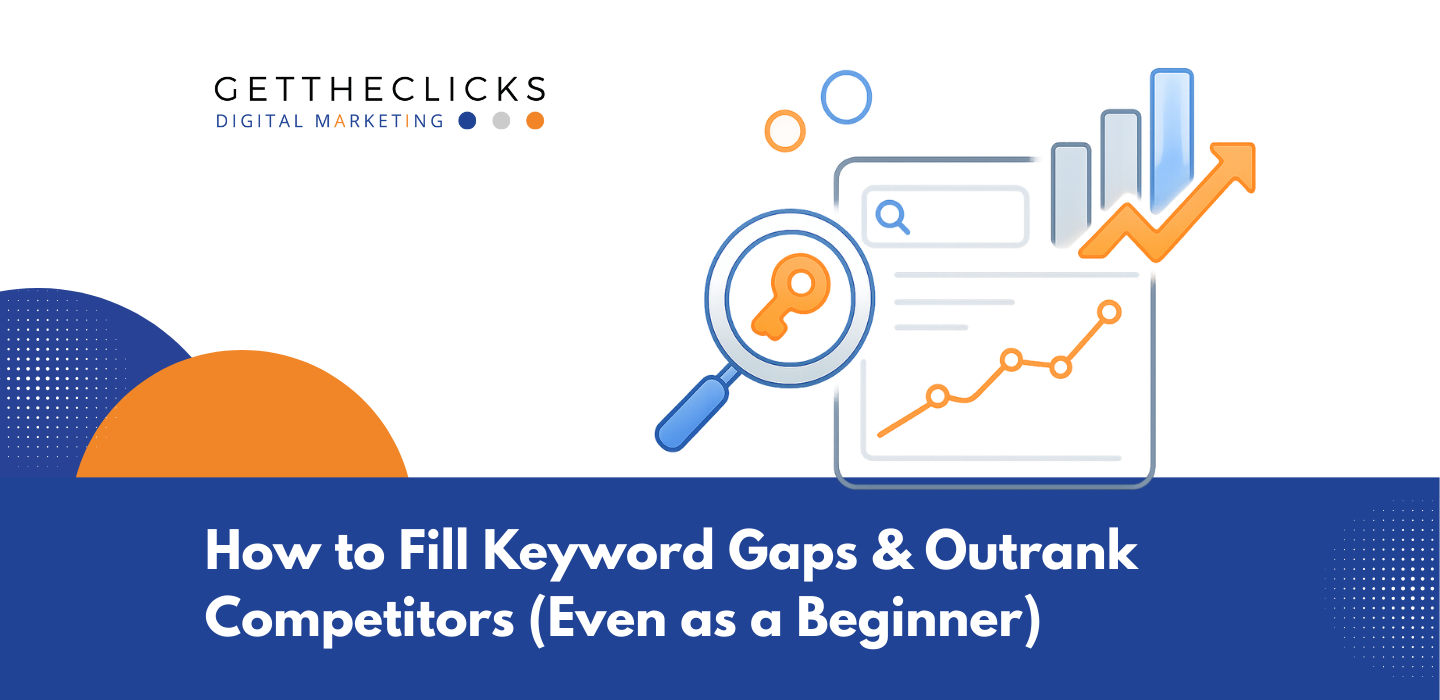If your content isn’t ranking and competitors perform better in search engines, you might be missing one critical piece: keyword gaps. These are untapped opportunities; search terms your audience is using but you’re not targeting. By uncovering and filling these keyword gaps, even beginners can boost visibility, drive more organic traffic, and chip away at the dominance of bigger players.
Keyword gap analysis gives you a smart, data-backed roadmap to rank for terms your competitors rank for. And the best part is that you don’t need a massive budget; you only need a knowledgeable SEO firm to get started.
What Keyword Gaps Are and How They Impact Your SEO
A keyword gap is a search term your competitors rank for, but you don’t. It’s not a penalty or a mistake on your end, just a missed opportunity. These keyword gaps often happen because SEO efforts focus too narrowly on a core set of target keywords, overlooking the long-tail keywords and topic variations your target audience uses.
It’s essential to distinguish keyword gaps from keyword cannibalization. While cannibalization occurs when multiple pages on your site compete for the same specific keyword, keyword gaps refer to areas you haven’t targeted at all. Identifying these areas means finding holes in your strategy, patching them up, and suddenly, catching much more organic traffic.
When you close keyword gaps, you attract users who previously visited your online competitors for answers. You’re not only expanding your reach; you’re doing so with content that’s often easier to rank for because it’s less saturated. That’s an effective edge, especially if you’re starting out.
At Get the Clicks, we find the keywords your competitors rank for that you’re missing, then help you create smart, targeted content so you can show up where it counts and pull in the traffic they’ve been getting.
How to Identify Your True SEO Competitors
Before closing keyword gaps, you need to know precisely who you compete with in search results, not just in business. Your real SEO competitors are the websites that rank for the keywords you want, whether or not they’re in your industry. For more on boosting local visibility, read this LSA Ads guide. To identify competitors effectively:
Search your target keywords on Google. The top-ranking websites are your immediate competition for visibility, regardless of their business type.
Use SEO tools like Ahrefs or Semrush: These platforms can show which competing domains share the most keyword overlap and offer powerful keyword gap tool functionality.
Look beyond direct business rivals: Blogs, forums, directories, and review sites may dominate the same keyword clusters you’re targeting.
Identify recurring domains in SERPs: Consistent appearances across multiple competitors signal strong relevant competitors.
Use keyword gap analysis features: Tools like Semrush’s Keyword Gap or Ahrefs’ Content Gap let you compare your rankings against competitors to find missing keywords and optimize your keyword strategy.
Get the Clicks digs into the search landscape to uncover who you’re really up against online. We can then help you target the right competitors, close the right gaps, and show up ahead of them where it matters most.
How to Perform a Keyword Gap Analysis with SEO Tools
Filling keyword gaps starts with the right tools and a systematic approach. Follow these steps to uncover keyword opportunities:
Step 1: Choose your SEO tool. Start with tools like Semrush or Ahrefs, with built-in keyword gap features ideal for this competitive keyword analysis.
Step 2: Enter domains for comparison. Input your domain and up to three organic competitors into the tool’s keyword gap analysis function.
Step 3: Analyze the keyword gap results. The tool will generate a list of keywords your competitors rank for that you don’t; these are your potential valuable keywords.
Step 5: Use Google Search Console for partial gaps. Look for organic keywords that get impressions but rank poorly; optimizing for these can boost performance quickly.
Step 6: Check internal site search data. Review what users are searching for on your website. If you’re not addressing those queries with content, that’s a content gap worth filling.
Step 7: Use Google’s site search operator. Type yourdomain.com [keyword] into Google to check if you already cover a topic; if not, it’s a clear content gap.
By following these steps, you will eventually outrank your competitors using keyword gap analysis. They help uncover high-potential keywords so you can begin creating content that competes directly with the keywords your competitors win on.
How to Prioritize Keywords Based on Potential ROI
Filling every keyword gap at once isn’t practical. Instead, focus on those with the highest potential return on investment. Look at three factors: search volume, keyword difficulty, and business relevance.
Start by targeting selected keywords that have moderate competition but strong search intent. For example, “email marketing tips for SaaS” may have lower volume than “email marketing,” but it’s highly specific and speaks directly to a target audience.
Also, consider the customer journey. Informational queries can build topical authority, while transactional queries align more directly with sales. Mix both in your content strategy for balanced growth.
Get the Clicks helps you zero in on high-ROI keywords by balancing search volume, competition, and intent. So you’re not just chasing traffic; you’re attracting the right visitors who are more likely to convert.
Matching Keyword Opportunities with the Right Content Format
Once you’ve selected keywords, the next step is choosing the correct content type. Every keyword signals a search intent; your job is to match that intent with the proper format.
If the keyword is “how to use a pressure cooker,” users expect a tutorial or guide. If it’s “best pressure cooker 2025,” they want a comparison post. For transactional queries like “buy pressure cooker online,” a landing page is best.
Look at what’s ranking now to understand what Google favors. The top-ranking websites for a given query will almost always follow the preferred format. Mimic that structure but add your unique value, whether original insights, updated data, or better visuals. This approach improves your relevance and online visibility.
Creating SEO-Optimized Content That Fills Keyword Gaps
Once you’ve chosen your keyword and the correct content format, it’s time to create high-quality content optimized for users and search engines. Your aim is to create content that addresses the user’s search intent.
- Include your target keywords in key elements: Use them in the title tag, URL, H1, meta description, and the first 100 words of your content.
- Structure your content for readability: Use descriptive subheadings, short paragraphs, and a logical flow to guide readers.
- Cover related keywords and subtopics: Address secondary queries to increase depth and topical relevance.
- Enhance content with visuals: Add images, charts, or videos to break up text and improve comprehension.
- Focus on clarity, not keyword stuffing: Write naturally and prioritize usefulness over repetition.
- Use SEO content tools: Platforms like SurferSEO or Clearscope help ensure you include semantically grouped keywords and keyword clusters.
- Aim for originality: High-quality content better satisfies search intent than your online competitors by being more helpful, clear, and informative.
Tracking Results and Improving Your Keyword Gap Strategy Over Time
Publishing is only part of the process; you must also measure results. Use Google Search Console to track impressions, clicks, and average position for your pages. Over time, you’ll see which individual keywords gain traction and which need refinement.
Check bounce rates and engagement metrics in Google Analytics. Low engagement may indicate poor search intent matching or weak content. Update with clearer landing pages, more structure, or better keyword ideas.
Re-run keyword gap analysis regularly. Your competitors’ rankings will change, and new, unique keywords will emerge. Finding keywords and refining based on data is how you increase organic traffic and build your authority.
At Get the Clicks, we don’t just help you launch SEO strategies—we continuously track performance, refine content, and adjust for new keyword opportunities so your traffic keeps growing and your rankings stay ahead of the curve.
Avoiding Common Mistakes in Keyword Gap SEO
Even great strategies can fail if you overlook the basics. Don’t mismatch search intent with content format. Don’t chase difficult keyword terms without building authority first. Don’t publish weak content to fill a gap analysis checklist. Google rewards value.
Instead, stay focused on valuable keywords, aligned formats, and authentic, well-structured, high-quality content. That’s the foundation for sustainable rankings, meaningful engagement, and SEO success.
Export your keyword lists to a CSV file, continually update based on performance and new keyword opportunities, and always be ready to adapt to your most relevant competitors and their competitors’ strategies. That’s how keyword gap analysis helps turn a static site into a traffic magnet.
Boost Your Rankings with Get the Clicks
Ready to turn keyword gaps into real growth? Get the Clicks helps you uncover missed opportunities, create high-performing content, and outrank your toughest competitors. Let’s build your SEO momentum—contact us today.





